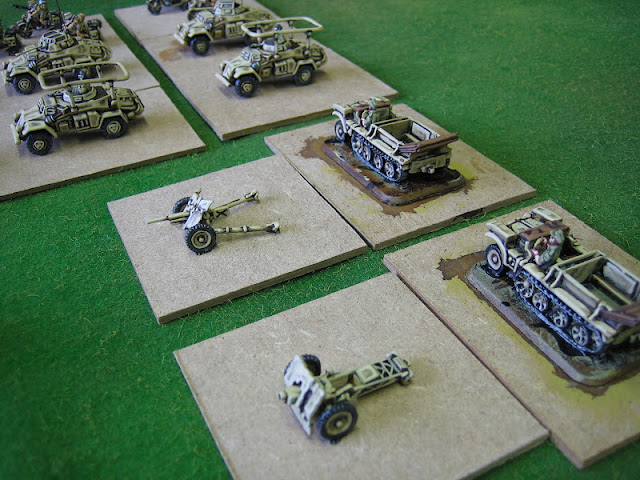Just for a change, Peter and I decided to throw something a little more heavy than pilums at each other. During my vacation from war game projects I've been enjoying painting a little bit of this and a little bit of that. Recently, I've been painting some Afrika Korps stuff for Operation Crusader and I have managed to complete Battle Group Cramer of 15th Panzer Division (less one coy of 15cm howitzers). Having already completed 22nd Armoured Brigade Group of 7th Armoured Division, I suddenly realised I could put together a tank battle.
The rules, largely based on classic Piquet's "Point of Attack - The Blitzkrieg", are still very embryonic. They are being designed to be very period specific - in this case covering Operation Crusader / Siege of Tobruk 1941, and the Gazzala Battles 1942 during the Western Desert campaign. As they stand, there is enough to do the basics, and rest can be explored or fudged as situations arise.
One quite interesting idea we tried last night, is to use the table tile grid for terrain definition - the tiles with a small hill in them are areas where hull downs might be found. There are few proper hills in the Western Desert, but the ground is not dead flat. The small hills (I'll be making some smaller purpose made mounds) are just movable markers. At the end of a movement within such a square a unit of vehicles, or deployed guns, can attempt to go 'hull down' by rolling their 'Other Difficulty' dice Vs D8. The German 'Other Difficulty' dice is D10 the British is D8. This dice is a catch all fall back used to decide odd situations not covered within the rules and includes the tactical nous of tank commanders. If a vehicle or gun finds a hull down it is marked with a cover marker which it can place to either front, flank, or rear (again, I'll be making some better markers than the 'dug-in' markers we used last night).
Anyway, the game worked fairly well, though it took some time to remember the differences between classic Piquet and Piquet, Field of Battle style. I took a few shot to commemorate the new units losing their cherry - or is that a bar mitzvah for the Germans?
The British seek the tactical advantage of 'rolling ground'.
The Germans bring up the heavy stuff.
This one stand unit (representing a battery of 4 guns) is absolutely lethal - in Piquet terms it's base fire dice is D12+1 even after taking account of the small numbers of guns - it's a real tank killer.
British Crusader tanks manage to find hull downs.
The virgins. 8th Panzer Regiment in wedges advancing, under fire, across open ground.


















































